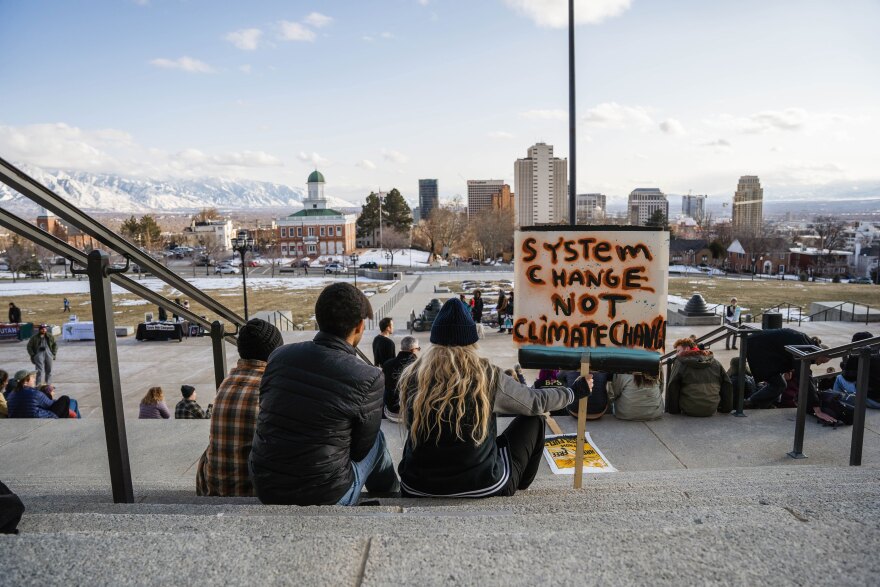The biggest themes of a climate strike held on the steps of the Utah State Capitol as lawmakers were finishing their work was a call to end fossil financing, improve Utah’s air quality and prevent the Great Salt Lake from drying up within 5 years.
Speaking to a group of 50 activists, Alex Veilleux from Save Our Great Salt Lake shared a to-do list of actions to save the landmark: including adding water to the lake now, setting a target water level of 4,198 feet, prioritizing conservation and stopping subsidizing water waste.
“This [legislative] session they talked a lot of game, you may have heard that they’re taking this issue seriously,” Veilleux said. “They had many, many opportunities to capitalize on actual action that could’ve helped the Great Salt Lake and most importantly gotten water to the lake now, and they just chose not to.”
As they worked over 45 days, lawmakers held back on some “emergency” water-saving measures because of the record snowfall this winter. Even so, researchers note that it will take more than one winter to break the West’s megadrought.
According to Veilleux, the high snowpack will probably only raise the lake level by 2 feet out of the 17 feet or so the lake needs to rise to a healthy level.
A resolution that would’ve set a target water level for the Great Salt Lake failed to make it out of committee. Another proposal would’ve diverted funds from controversial and water-intensive projects the Lake Powell Pipeline and Bear River Development to a lake-specific fund for five years, but it too stalled in committee.
Nain Christopherson, a teacher at West High School who attended the climate strike, said the lack of emergency measures to save the Great Salt Lake made her feel “deep frustration and anger.”
“I think it's OK to say we're really grateful for the snow, it's helpful,” Christopherson said. “But that doesn't absolve our leaders of responsibility to address this problem, so it's disappointing to see them treat this lucky weather year as an excuse not to act.”
Actions lawmakers did take included creating the Office of the Great Salt Lake Commissioner, budgeting $200 million to help farmers irrigate more efficiently and more funding for turf buyback.
Brandi O’Brien began her speech to the climate strikers by sharing a saying they have at Utah Physicians for Healthy Environment.
“Ask your doctor if clean air is right for you,” she said. “If he says no, you need a new one. That stands for the Legislature as well. The science is clear that there is no safe level of air pollution.”
Like the shrinking lake, Utahns also worry about the state’s notorious air quality. Winter inversions are a fact of life, but a recent National Oceanic and Atmospheric Administration study pointed a finger at U.S. Magnesium for its contribution to the smog. One Democrat’s attempt to slash emissions and target the company was scaled back in the session to a study of the effects of bromine and other pollutants.
O’Brien added that Utah has a bad habit of allowing developers and industry polluters to have their way rather than protecting the health and well-being of residents.
“The youth are not responsible for our dirty air or energy policies of the current day, but we are the ones that will have to live with the impacts,” she said.
The Salt Lake City climate strike was one of many across the world in March held by the youth-led and organized movement Fridays for Future. The movement started in 2018 when climate activist Greta Thunberg, who was 15 at the time, sat in front of the Swedish parliament every school day for three weeks to protest the lack of action on the climate crisis.
Britt Wray, a climate and mental health researcher, conducted a survey of 10,000 16- to 25-year-olds from 10 different countries to try to better understand the psychological impact that climate change has on youth.
“We're really alarmed by what we found,” said Wray, author of the book Generation Dread: Finding Purpose in an Age of Climate Crisis. “Forty-five percent of the global respondents told us that their thoughts and feelings about the climate crisis are negatively impacting their daily functioning. So that means eating, sleeping, concentrating, basic tasks”
The survey also found that 75% of respondents said that the future is frightening to them because of climate change, and more than half felt humanity is “doomed” because of it.
“This really puts into stark relief the existential pressure that young people are feeling,” Wray said. “They reported emotions like being sad, anxious, angry and all of this was linked with feeling betrayed by governments and lied to by leaders.”
Raquel Juarez, one of the organizers of the strike in Salt Lake City, said she feels the climate crisis is negatively impacting her day-to-day.
“But it does shock me because I realize from those words how much dread the youth have, [which] makes it all the more important to include them in spaces like these in order to give them a purpose and not feel lost.”
Wray said while it’s important to recognize the pressures of climate change on young people, hope should not be lost.
“Climate anxiety has been linked to panic attacks, restlessness and inability to work, depression, anxiety that can become clinical and its severity,” Wray said. “But it can also really galvanize people towards action and coming together with others and fostering community resilience”





